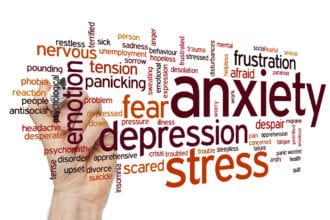It’s a normal part of life to feel anxious every now and then. It’s known as the fight-or-flight response, and is a way for the body to respond to threats and stressful situations, as well as to protect itself. Your sympathetic nervous system turns on when anxiety kicks in you. It prepares you for action by increasing your heart rate and alertness. It’s the reason why anxiety can actually be helpful when preparing for a big presentation. In times of need, it also kicks in as an instinctual protective mechanism, like after a car accident.
The problem starts when the body is constantly in this mode. It means you’re always geared up for action and worried and anxious over everyday events. Such an amount of anxiety may be indicative of a generalised anxiety disorder (GAD) and can become incapacitating.
Symptoms of generalised anxiety disorder are similar to other types of anxiety, such as obsessive-compulsive disorder and panic disorder, but they’re all different conditions. It’s possible to develop GAD as a child or an adult.
Read on to learn more about generalised anxiety disorder and its signs and symptoms.
Generalised Anxiety Disorder: What Really Is This Condition?
GAD is defined as persistent worry over something for more days than usual for at least several months. In generalised anxiety disorder, an individual has nearly constant or frequent nagging feelings of anxiety or worry. In some cases, a person with GAD feels that they have always been a worrier since childhood or adolescence. In other cases, generalised anxiety disorder may be triggered by a period of stress or a crisis, such as the death of a relative, a family illness, or a job loss. The unexplained feeling of anxiety can last for months or even years, even if the stress or crisis has already ended.
People with GAD may feel insecure or may have low self-esteem, in addition to suffering from nonstop or constant anxieties and worries. Individuals suffering from generalised anxiety disorder may see events or other people’s intentions in negative terms. They may also experience them as critical or intimidating. Stress can intensify the anxiety. Physical symptoms that people with GAD experience may lead them to seek professional treatment from a gastroenterologist, pulmonary specialist, cardiologist, or primary care doctor.
The Difference Between Generalised Anxiety Disorder And “Normal” Worry
Again, it’s natural to worry about your finances after some unexpected bills hitting your way or be anxious about an upcoming test. Fears, doubts, and worries are a normal part of life. The difference between GAD and “normal” worrying is that the generalised anxiety disorder-associated worrying is disruptive, persistent, intrusive, and excessive.
The Difference Between Generalised Anxiety Disorder And Phobia
Individuals with phobias are fearful of something–for example, speaking in public, heights, or spiders. Generalised anxiety disorder (GAD) is different from having a phobia about something in particular.
If you have GAD, you actually develop an uneasy feeling about life overall. For example, you may start to worry that your friend is upset with you, or that you did something wrong when they don’t call you back within one hour. You may even begin to fear that your friend was in an accident if you’re waiting for them to pick you up, but they’re a few minutes late. Instead of thinking about something that’s more minor, like your friend getting stuck on traffic or something significant came up to him, you always have these negative thoughts in you. You’re in a state of constant worry, often associated with feelings of unease or dread over everything.
Generalised anxiety disorder results in having anxiety toward life in general. Such a feeling is not as intense as those that take place during a panic attack episode, but they’re long-lasting. It causes an inability to relax, that’s why some experts consider it far more debilitating when compared to a specific phobia to a certain situation or thing, which you could just possibly avoid. With GAD, there’s no “off” switch–you can’t avoid experiencing a constant state of worry if you’re suffering from this particular condition. Life, in general, causes you anxiety.
Signs And Symptoms Of Generalised Anxiety Disorder In Adults
Most people with generalised anxiety disorder experience a combination of physical, behavioral, and emotional symptoms that often fluctuate and become worse at times of stress. It’s essential to note, however, that not everyone with GAD has the same symptoms.
- Physical Symptoms Of Generalised Anxiety Disorder
Adults with GAD experience physical symptoms that include the following:
- Diarrhea, nausea, stomach problems
- Feeling jumpy, restless, or edgy
- Having trouble staying asleep or falling asleep because their minds just won’t quit
- Feeling tense and having body aches or muscle tightness
- Behavioral Symptoms Of Generalised Anxiety Disorder
Adults with GAD experience behavioral symptoms, including:
- Avoiding situations that make them anxious
- Putting things off because they feel overwhelmed
- Difficulty focusing on things or concentrating
- Inability to be by themselves, enjoy quiet time, or relax
- Emotional Symptoms Of Generalised Anxiety Disorder
Adults with GAD experience emotional symptoms that include the following:
- A pervasive feeling of drear or apprehension
- An inability to tolerate uncertainty or the strong feeling of needing to figure out what’s going to happen in the future
- Intrusive thoughts about things that make them anxious or trying to avoid thinking about anxiety-causing thoughts, but they can’t
- Feeling like their anxiety is uncontrollable or there’s nothing they can do to stop the worrying
- Constant worries running through their heads
- Generalised Anxiety Disorder Symptoms In Children
Unlike adults with generalised anxiety disorder, teens and children often don’t realize that the anxiety they’re experiencing is disproportionate to whatever challenging situation they’re in, so adults must be the ones to recognize their symptoms. In children, excessive worrying centers on school performance, personal abilities, family matters, social acceptance, past behaviors, and future events. Along with many of the signs and symptoms of GAD that appear in adults, some red flags in children are:
- Need for frequent approval and reassurance
- The conviction that misfortune is something contagious and will also happen to them
- Feeling that they’re the one to blame for any disaster
- Fear of making mistakes, excessive self-criticism, perfectionism
- “What if” fears regarding situations far in the future
Final Thoughts
Generalised anxiety disorder (GAD) occurs along with mood disorders and other types of anxiety in most cases. Living with generalised anxiety disorder (GAD) can be a long-term challenge. Thankfully, relaxation techniques, learning coping skills, and making lifestyle changes can help.









